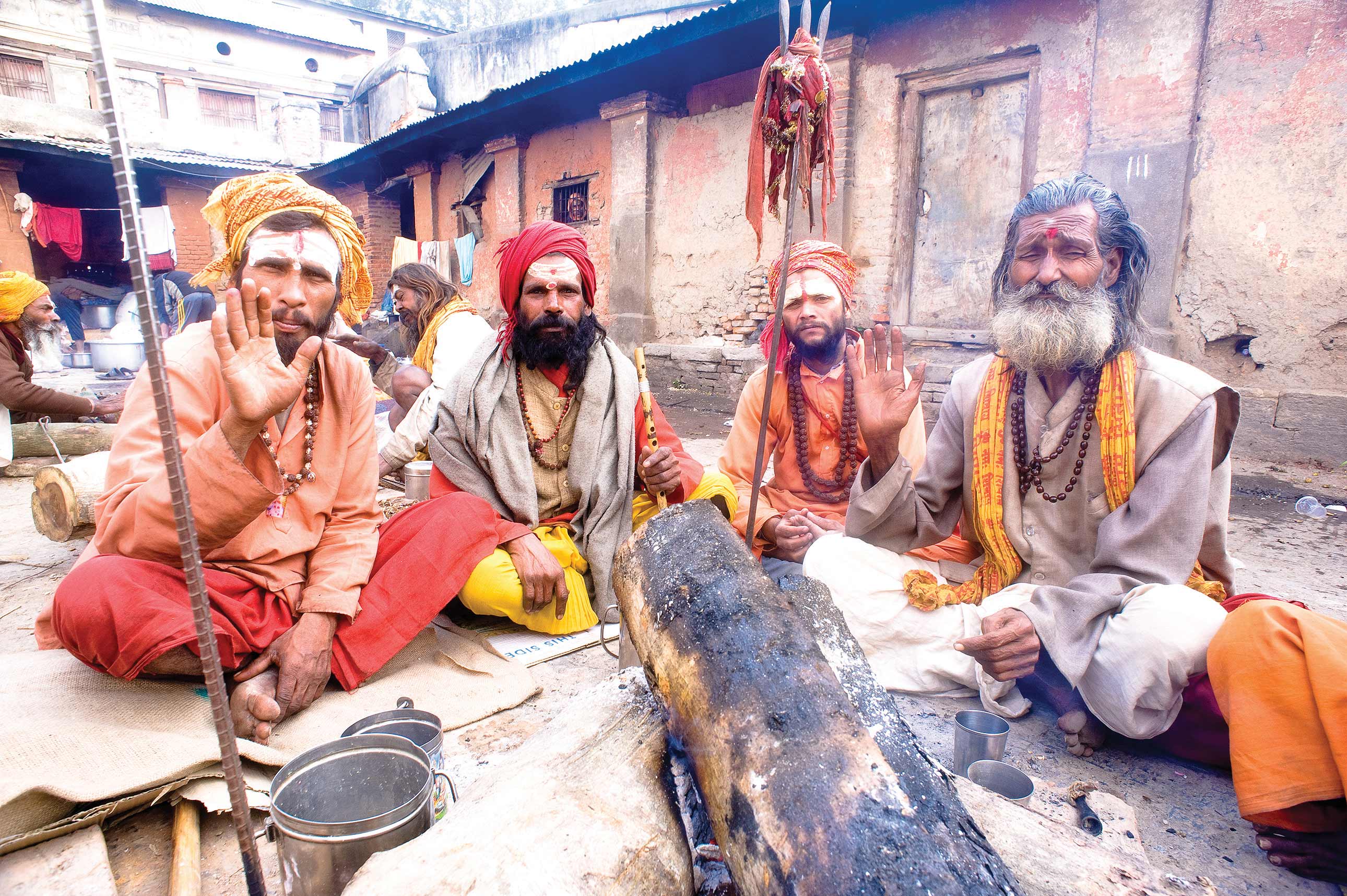Wild boar are shy by nature, but when challenged they can be treacherously aggressive. Stalking them is difficult and shooting them dangerous, for they are known to retaliate swiftly if wounded. They are by far one of the toughest of game to bring down.
The rain stopped; but it did little to comfort me as low lying ominous looking clouds still hung menacingly overhead. I crawled out of the machan, the hunter’s watch tower, to stretch my legs, wincing as I stood on pins and needles. Heavy-eyed I peered down the ridge into the corn field that stretched downhill into a narrow gully. Although I could make out the cornfield, my visibility (in spite of the moon) extended hardly ten yards. I cocked my head and strained hard to listen to any strange sound, but all I heard was the distant sound of gushing water from a nearby stream.
For close to two hours I had lain crouched on the machan with my shotgun cradled on my lap and a torch clutched in my hand, lying in wait for that night’s quarry – wild boar. Then, around midnight, all hell broke loose – at least that’s what I thought. I must have dozed off when the sound jerked me wide awake. Instinctively I grabbed for the gun, my heart in my mouth. In the frantic lunge the torch slipped through my hand and I swore to myself. Groping around in the darkness, I found it lying on the machan floor. The shrill note, which at first seemed very close, came from the opposite hillside. Alas, it wasn’t the grunt or squeal of a wild boar I was expecting, but the beating of an empty tin. Then it stopped and the stillness of the night was ripped by a hoarse cry – Ho, Ho, Ha, Ha! – bouncing off the hillside. A barn owl hooted nearby adding more eeriness to the night, sending goose pimples down my spine.
The next morning the first villager I met told me that the nighttime racket was intended to keep the wild boars away from destroying the crops.
I had kept vigil patiently throughout the moonlit night, though it became more and more uncomfortable by the passing of each minute. That late July night after rain was relatively cool, but to my great misery, the cursed mosquitoes were out in full force. To make matters worse, my skin crawled at the thought of the many leeches gorging on the blood around my ankles inside the warmth of my trainers.
Where’s Bhirkot?
The reader might mistake the setting I describe for some village located far off in the countryside. The locale, however, was a little village called Bhirkot no more than 12 kilometers from the heart of Kathmandu. It was in the early 1990s when I spent the night up in that machan, with two of my hunting companions in other locations around the corn fields. Our purpose was to shoot the wild boar that were destroying the crop. Barely a half hour ride due west of Sitapaila to Ramkot, then a 45 minute hike uphill to the north, Bhirkot is a cluster of 30 to 40 houses (in those days) scattered amidst terraced fields. A stunning view of Kathmandu valley dominated the southeast, while the towering ridge of the Nagarjun Forest Reserve, a haven for wild boar, flanked the northeast. The landscape west of Bhirkot stretched into the forested hills of Bhimdhunga.
I had never heard of Bhirkot until one day Ramesh, my shooting companion and a medical doctor, told me about it. He once had a patient from Bhirkot, he said, who besides his ailments bemoaned the havoc wreaked by wild boar in his village. That was all the enticement we needed. Hunting fanatics that we were, we set off for Bhirkot the following weekend, intent on remedying the situation. Govinda, our village host (Ramesh’s patient), assured us that it was okay to shoot the boar as the villagers had received written permission from the village committee. Nirmal, another of our partners, joined us for the hunt at the last moment. Our arsenal included an odd assortment of 12-gauge shotguns. Ramesh carried a Russian make Baikal single barrel that when shot in succession got the barrel flinchingly hot. Nirmal sported an antique British gun, an ominous looking 34 inch Greener inherited from his father that often jammed at the wrong moments. I had a double-barrel Webley & Scot (also British) that allowed me an edge over my partners, as I could go for a quick second shot if necessary.
Our visit to Bhirkot confirmed that the plight of the villagers was real. At several locations, the maize crop – or what remained of it – lay strewn around, trampled and chewed every way we looked. The fields adjacent to the walls of the Nagarjun forest were the worst hit. It appeared as if entire fields had suffered a massive typhoon overnight. It really beat us how on earth the boar managed to cross into the fields, confined as they were into the forest by a sturdy looking wall. On close examination, however, we saw that the wall was not high enough at places to frustrate the sinewy legs of the wild boar and that in a few places the wall had collapsed.
The wild hogs apparently stormed the fields in pairs or groups, covering as many as eight to ten different spots in a single visit. Not in daylight, of course. Smart and wary, the visitors from the wild bid their time until dark before sneaking out of the nearby jungle and into the fields. If the rampage caused by a single night’s sortie continued unchecked, I could well imagine what would happen to the remainder of the crop before harvesting time.
The villagers had done everything possible to protect their crops from the nocturnal marauders. Each night sentinels were kept, and empty tin cans beaten to scare the swine away; and, with the help of government shikaris (hunters), a few were even shot each year. Given those efforts, the village folks saved what little they could from their meager fields. But nothing seemed to stop those animals from getting stronger in number and force with each passing year. Most of the villages lying outside the walled Nagarjun forest (Thaplebhir, Odare, Chilaunegaon, and others) were tormented by the wild pigs. “And the villages surrounding the Shivapuri Reserve forest (now a National Park) are also undergoing the same fate,” Govinda, our host, informed us. “The boars have grown in numbers so rapidly each year that both the Nagarjun and Shivapuri forests fail to provide for them,” he added.
The main reason for such rapid growth in the number of wild boar is simple: basically, the biological phenomenon of reproduction. A prolific breeder, a sow bears as many as five or six piglets, up to twice a year. The gestation period is only four months. ‘Culling’ of the boar to strike a balance by introducing predatory animals (like leopard or tiger, whatever suits the terrain), sustained hunting or relocation to other forests, was not then in effect in Nagarjun or Shivapuri. And although the forests did have some leopards at the time, they were ineffective in reducing the flock. Besides the native wild boars, the Nagarjun forests also sheltered their much heftier Russian cousins, which were introduced as gifts from the Russian government during King Birendra’s rule in the mid-1980s.
Given the wild pig population boom and their notorious gluttony, the forests of Nagarjun and Shivapuri had inadequate food for them. So they had moved out beyond the perimeters of the forest walls, and where else but to the neighboring fields of maize, millet, buckwheat and mustard in season, and all the wild tubers, roots, and fleshy trailing or climbing plants that also grew there. Literally anything that grew over or beneath the soil was food for those wild critters.
My vigil on the machan that night ended with the first streaks of dawn without sight nor sound of a wild boar. I clambered down and called out to the old man sleeping in a nearby cowshed. As I bid him goodbye on my way back to town, he appeared very grateful and mumbled some words of thanks for having kept the night watch for him. The poor fellow, I thought, slept well after a long time since I had relieved him for the night. Maybe he believed his crops were spared that night, as the boar dared not venture near with armed hunters from the ‘city’ lurking around. “Hajoor,” he said respectfully, “each night my son Maila and I take turns to shoo the pigs away,” was his parting lament.
Treacherously Aggressive
I knew that neither of my companions lying in wait at 200 yard intervals had any better luck, as no tell-tale sound of gunshot was heard during the night. Ramesh, however, had a hair-raising experience to describe. Around midnight, he clearly heard a boar barely 20 paces from where he was crouched amidst the maize plants. He stalked it in darkness, virtually crawling on all fours, until he thought he could all but reach out and touch the animal with his bare hands. Apparently unaware of the imminent danger from Ramesh, the boar kept chomping and gnawing, the sound almost like small crackers going off in the calm of the night. Shaking from nervousness, his heart pounding in his chest, Ramesh squinted in the dim moonlight to locate the source of the noise. He knew that to venture further would put him in danger of being cut up by the beast’s razor sharp tusks. That would have been fatal. And since, as a good hunter he had to have full sight of the quarry, he could not shoot at the sound alone. Ramesh made frantic silent gestures to the frightened villager who brought up the rear to switch on the torchlight, but before he could the boar spooked and in an explosive dash it brushed past Ramesh in a dark blur and was gone. Ramesh’s remark at telling of this encounter was that he almost suffered a “cardiac arrest”.
Wild boar are shy by nature, but when challenged they can be treacherously aggressive. Stalking them is difficult and shooting them dangerous, for they are known to retaliate swiftly if wounded. They are by far one of the toughest of game to bring down. Even when fatally shot their instinct is to rush towards the source before dropping to the ground. This happened to me once in the Terai forest. The hunter’s rule of thumb is not to mess with wild boar. Most hunters either shoot them from a machan or some other safe vantage point, to avoid being attacked. Nighttime shooting is even more difficult, and dangerous, as boar (unlike deer, rabbit or animals of prey) are not blinded into immobility when caught out in the sharp beam of a torch or powerful spotlight. Instead, they spook.
Last to appear that morning was a weary Nirmal with blood-shot eyes, droopy shoulders, and disappointment written all over his face. He, too, had had a rather bizarre encounter. “I saw not one but two of them,” he told us. After an uneventful vigil all night in a tree, Nirmal climbed down and joined another villager to return home. As they trudged down the slope to meet us, he heard faint sound of people talking in the distance. It never for a moment occurred to Nirmal that a wild boar might cross their path since it was highly unlikely for a boar to hang around after first light. But one did. Caught unawares, the two men froze in their tracks, their eyes locked on a big boar hardly ten feet away. “Time stopped,” Nirmal said. He could only hear his heart kicking furiously at the sight of the big black boar staring back at him. Then, in a flash, the beast dashed for the nearest cover before Nirmal could flinch a muscle. Then, to his surprise yet another big boar whizzed past in a blinding flash.
So went our wild boar hunt. Back at the village, as we sipped hot tea at Govinda’s house he graciously helped soothe our spirits by assuring us of good luck the next time. We thanked him and the many villagers who thronged to bid us goodbye. Then we set off down the slope towards Ramkot, towards home.
As I lay in the comfort of my bed that next night musing over the sequence of events at Bhirkot, the face of the old man kept flashing in my mind. He was probably sitting it out again on the machan fighting what at his age was a wretchedly lonely and hostile battle against the crafty wild critters. Maybe we ought to make one of those hunting trips to Bhirkot again, if only for the old man’s sake, I thought. Regretfully, however, I’ve never gone back.
It’s been 16 years. While writing this story I phoned Govinda for an update on today’s Bhirkot. Not much has changed, he said, except for an uneven gravel access road, a school and a few more houses. The wild boar still invade the crops, mostly when the maize is ready, though their numbers are slightly down from years past. According to Govinda, the reason may be the thriving lush forest of the Nagarjun with plentiful food and little or no human encroachment. He also suspects that some killer disease may have spread among the animals, causing a decline in their numbers. Thus, it seems, there has been some natural respite for the villagers.
Ravi Man Singh is a freelance writer and outdoor sportsman who lives in Kathmandu. He can be contacted at ravimansingh@hotmail.com.
Gokarna Forest Resort The Royal Hunting Ground
As you drive along the winding roads that lead you to the gates to Gokarna Forest Resort, its hard to...









